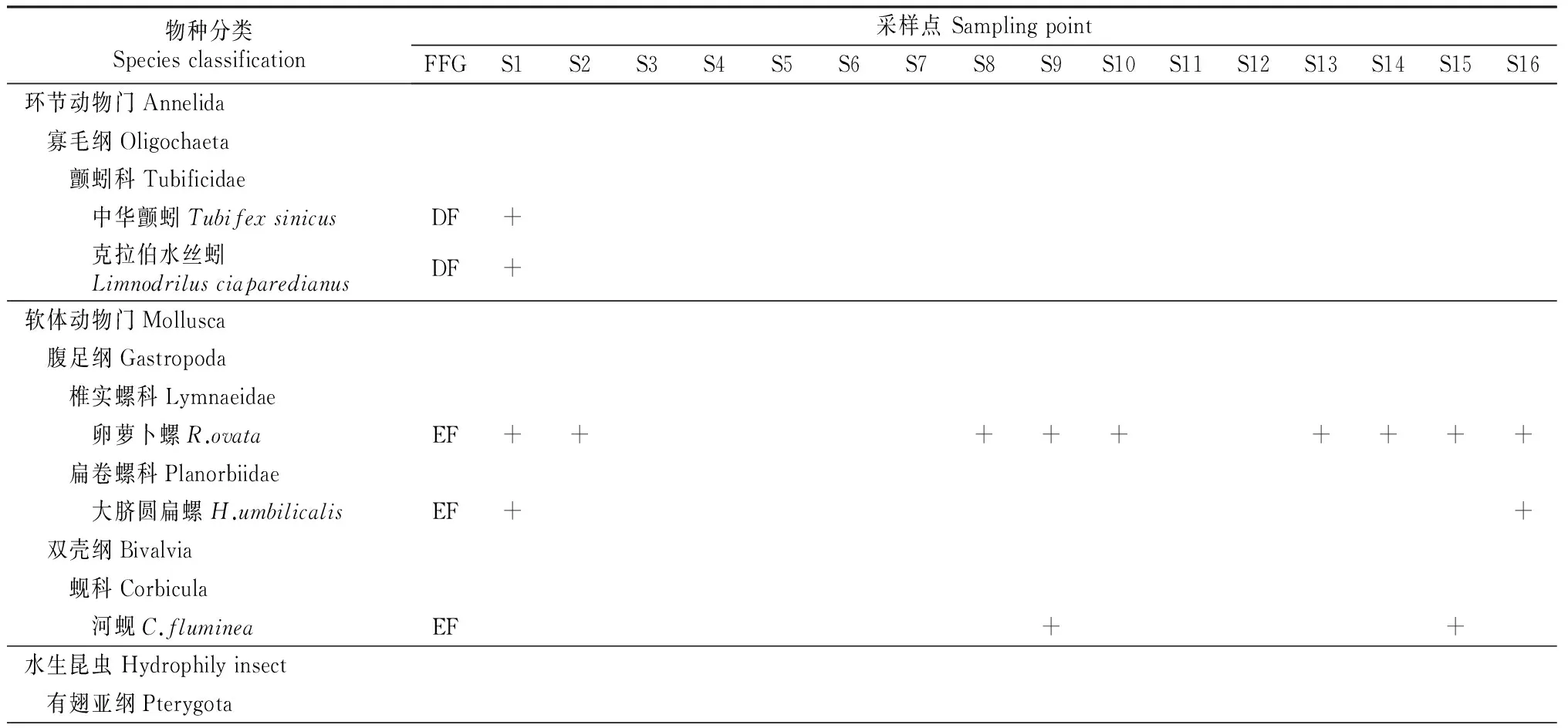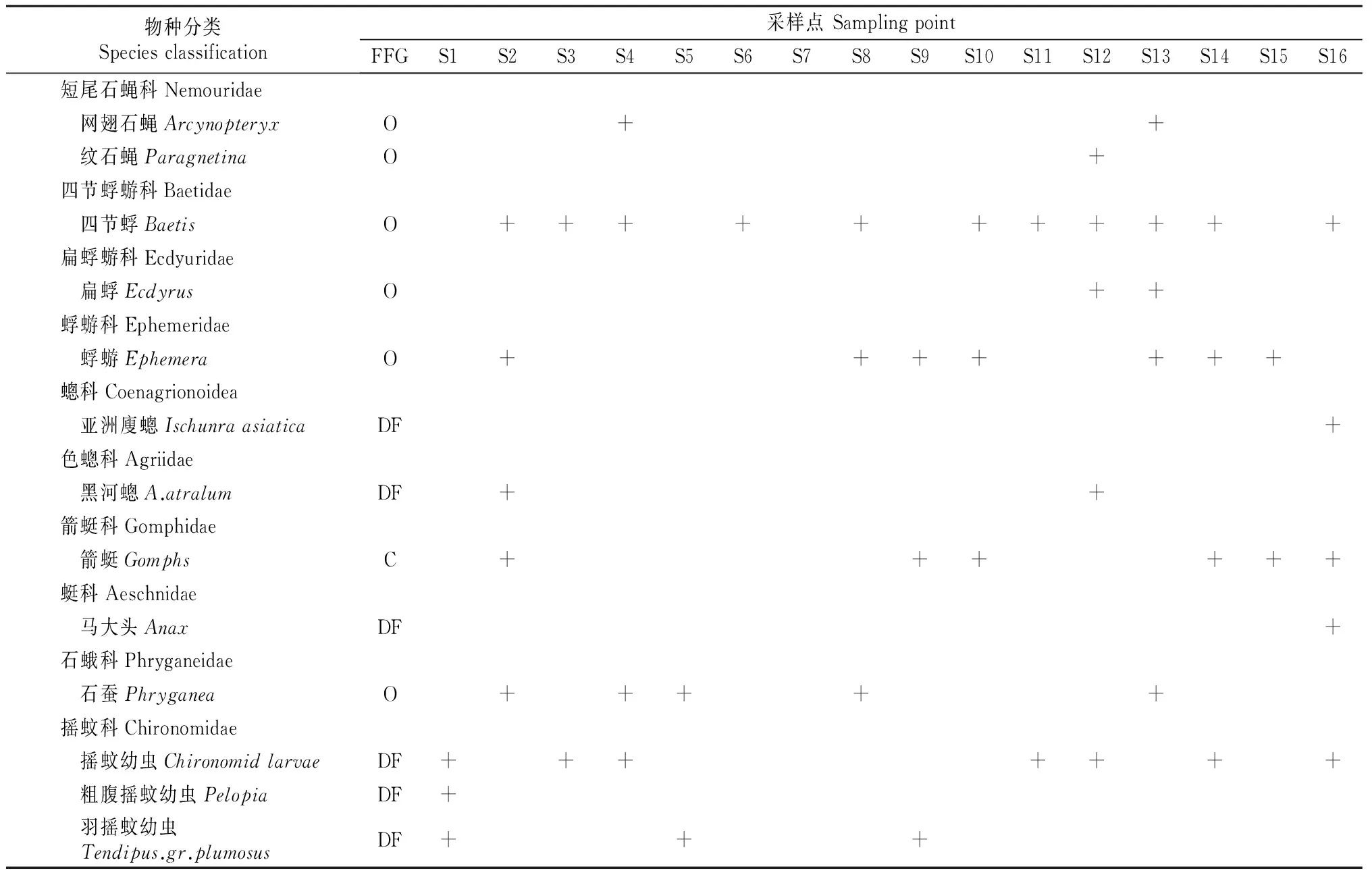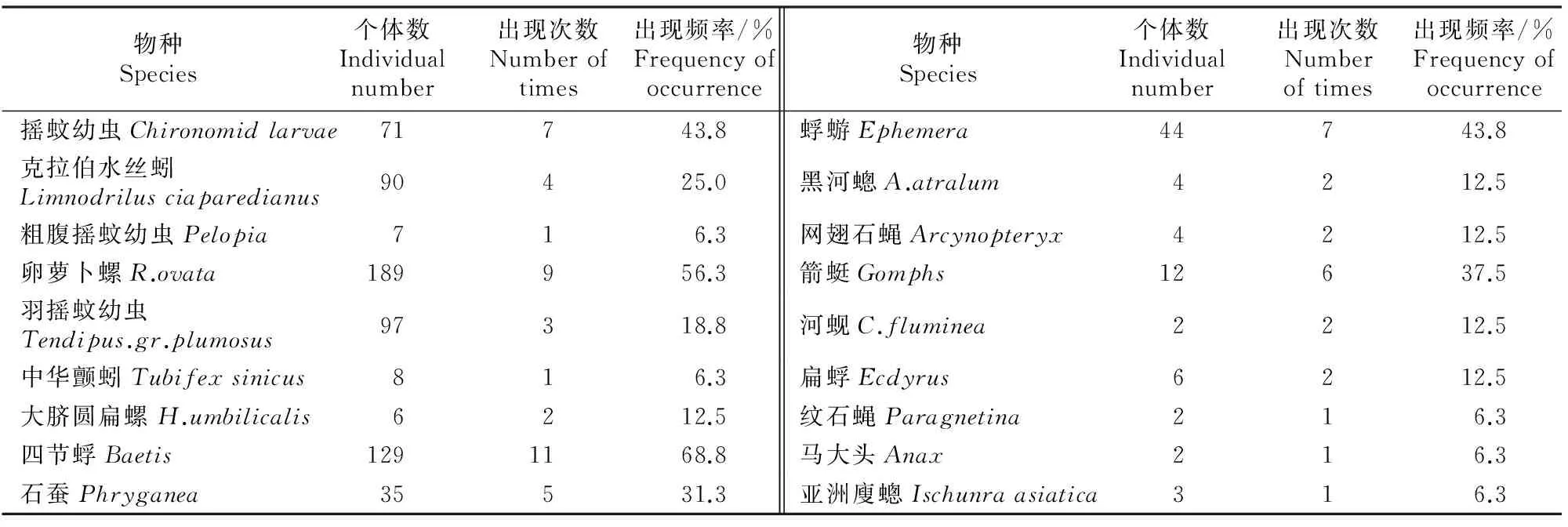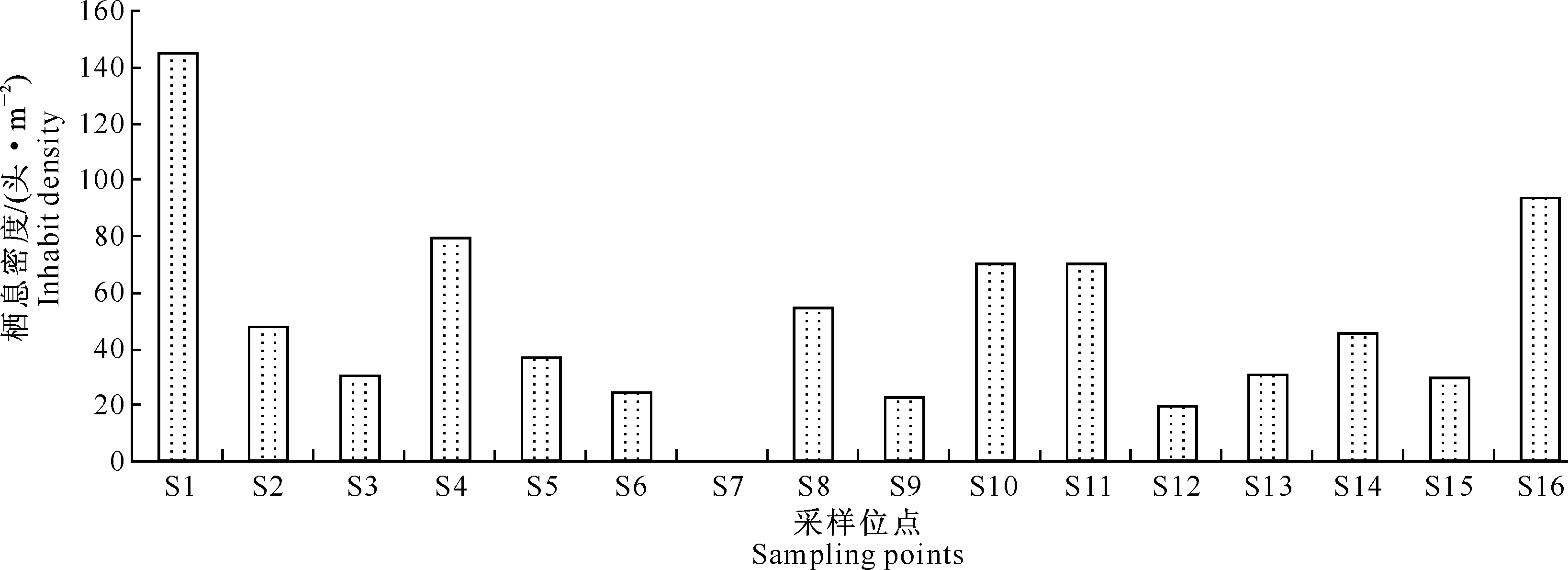秦岭丹江流域底栖动物生态学初步研究
2016-09-19苟妮娜靳铁治张建禄王开锋
苟妮娜,边 坤,靳铁治,张建禄,王开锋
(陕西省秦岭珍稀濒危动物保育重点实验室,陕西省动物研究所,陕西 西安710032)
秦岭丹江流域底栖动物生态学初步研究
苟妮娜,边坤,靳铁治,张建禄,王开锋
(陕西省秦岭珍稀濒危动物保育重点实验室,陕西省动物研究所,陕西 西安710032)
【目的】 了解秦岭丹江流域底栖动物的群落结构特征和多样性规律,为水域生态学研究提供基础资料,也为南水北调中线工程重要水源区生态环境评估提供科学依据。【方法】 于2014年春季在秦岭丹江流域,选取6个样区16个样点,采集样品,调查底栖动物群落结构和分布特征。【结果】 鉴定出底栖动物18种,隶属3门4纲14 科, 其中水生昆虫类最多,分属10科13 种,占总数72.2%;软体动物3种;寡毛类2种。四节蜉属(Baetis)动物的出现频率最高,达68.8%。春季丹江流域底栖动物的优势种为卵萝卜螺(R.ovata)、四节蜉(Baetis)、摇蚊幼虫(Chironomidlarvae)、克拉伯水丝蚓(Limnodrilusciaparedianus),食底泥者是秦岭丹江流域底栖动物主要的功能摄食类群,共有8种。丹江流域底栖动物平均密度为50 头/m2,单因素方差(ANOVA)分析表明,底栖动物Shannon-Weiner、Pielou、Simpson指数在不同样点之间差异不显著。【结论】 秦岭丹江流域底栖动物群落结构相对稳定但分布不均,反映出水域生态环境优劣差异。建议应加大对秦岭丹江流域生态系统的治理,控制污水排放量,构建一个和谐稳定的丹江流域生态系统。
丹江流域;底栖动物;秦岭
底栖动物具有活动范围广、迁徙能力差、生命周期长、标本易采集、对外界干扰反应敏感等特点,直接参与水生态环境物质和能量的循环过程[1],对河流的保护、利用和管理具有指示作用[2-9]。早在1931年,Farrell就曾指出,底栖动物种群能将水环境条件的过去和现在指示出来[10]。欧美等国家的环保部门很早就将底栖动物应用于水环境监测方面。目前,国内河流底栖动物的研究区域主见于东北地区的黑龙江[11]、松花江[12],南部地区的珠江、流溪河[13],中部地区的洞庭湖[14]、东湖[15],东部地区的安溪丰溪河[16]等,对西部水域的研究较为缺乏,只有少量关于黄河[17]以及雅鲁藏布江[18]和青海湖[19]等底栖动物的报道。
秦岭山脉横贯我国东西,是南北气候和自然地理的分界线,又是南北生物物种的交汇地带,是中国地质和生物的中央公园。丹江流域是秦岭山脉重要的水源涵养地之一,也是南水北调中线工程的重要水源区。目前,有关丹江流域底栖动物调查研究,仅见零星的关于丹江口水库的报道[20]。本研究在秦岭丹江流域选取6个样区16个样点,对其底栖动物群落结构、分布特征以及多样性进行了较全面的研究,以期为秦岭丹江流域的水生态环境保护提供科学依据。
1 材料与方法
1.1研究区概况
丹江流域发源于陕西省秦岭南麓,属长江二级支流,全长443 km。丹江流域地形由西北向东南降低并敞开,具有南暖温带-北亚热带的过渡带气候特点。流域内植被较好,多为次生林,地貌起伏变化很大,山大沟深,一般海拔在600~1 200 m。丹江水系有196条河流,较大的河流有银花河、板桥河、武关河等。
1.2采样点的布设
本次调查选点在秦岭丹江流域干、支流,选择湘河镇、竹林关、商丹开发区、中村镇、二龙山水库、黑龙口镇6大样区共16个采样位点进行调查(图1),具体采样位点信息见表1。

图 1 秦岭丹江流域调查样区示意图Fig.1 Map of the Danjiang River basin in Qinling表 1 采样位点分布及海拔Table 1 Elevation,distribution of the sampling sites

样区Samplingarea采样点序号Samplingpointnumber采样位点Samplingpoint海拔/mAltitude样区Samplingarea采样点序号Samplingpointnumber采样位点Samplingpoint海拔/mAltitude二龙山水库Erlongshanreservoir黑龙口Heilongkou商丹开发区Shangdandevelopmentarea竹林关ZhulinguanS1S2S3S4S5S6S7S8二龙山水库Erlongshanreservoir前街Qianjie铁炉子Tieluzi月亮湾Yueliangwan堡子Baozi何塬Heyuan费村Feicun冀家湾Jijiawan76588710411229574636690407竹林关Zhulingguan中村Zhongcun湘河XiangheS9S10S11S12S13S14S15S16梁家湾Liangjiawan堰坝Yanba上窄巷Shangzhaixiang捷峪Jieyu弯里Wanli大泉Daquan枣园Zaoyuan大桥上Daqiaoshang402409578627768225230240
1.3样品的采集和鉴定
于2014年春季(4-5月)对秦岭丹江流域底栖动物分别进行定量、定性采集。定量采集方法一种是泥底断面法,使用1/16 m2彼得逊采泥器采集底泥,用孔径0.25 mm分样筛进行筛选;另一种是在河滩及浅水处用D型网取样,通过测量D型网面积和采样距离进行定量计算。每个调查点随机定量采集5次。所采集底栖动物用4%甲醛溶液固定后带回实验室,再移入75%酒精中长期保存。在室内进行种类鉴定、个体计数,计算栖息度。参照Wetzel[21]、刘健康[22]、彭松耀等[23]、王备新等[24]国内外学者的研究结果对底栖动物的功能摄食类群进行划分。
1.4群落的多样性指数计算
Shannon-Wiener指数(H′)[25]:

Pielou指数(J)[26]:J=(-∑PilbPi)/lbS。
Simpson指数(D)[27]:D=1-∑(Ni/N)2。
式中:S为总物种数;Pi为i物种的个体数占总个体数的比例;Ni为i物种的个体数;N为所有种的个体总数。
2 结果与分析
2.1底栖动物的种类和分布
调查结果(表2)显示,在16个采样点共发现底栖动物18种,隶属3门4纲14 科, 其中水生昆虫类最多有10科13 种,占72.2%;软体动物有3科3种;环节动物有1科2 种。S1和S16样点动物种类最多,均为7种;其次是S2、S13、S14,为6种;其他样点的底栖动物种类数为2~5种。功能摄食类群分析结果表明,春季食底泥的底栖动物最多,共8种,杂食者6种,滤食者3种,肉食者1种(表2)。

表 2 秦岭丹江流域底栖动物调查结果Table 2 Investigation of zoobenthos in Danjiang River basin in Qinling

表 2(续) Continued table 2
注:+ 表示有;FFG.功能摄食类群;FF.滤食者;DF.食底泥者;C.肉食者;O.杂食者。
Note:+ represents existence;FFG.Functional feeding group;FF.Filter feeders;DF.Deposit feeder;C.Carnivores;O.Omnivores.
2.2底栖动物的数量和栖息密度分析
调查结果(表3)显示,所有底栖动物中,出现频率最高的是四节蜉,达68.8%;其次是卵萝卜螺和摇蚊幼虫,出现频率分别为56.3%和43.8%。秦岭丹江流域各种底栖动物的密度为0~145头/m2,平均密度为50头/m2,其中S1样点底栖动物栖息密度最高,达145头/m2(图2)。

表 3 秦岭丹江流域底栖动物个体出现次数和频率Table 3 Individuals and occurrence frequencies of zoobenthos in Danjiang River basin in Qinling
2.3底栖动物的群落多样性分析
秦岭丹江底栖动物群落多样性指数见图3。由图3可知,秦岭丹江底栖动物群落的Shannon-Wiener指数为0~2.19,Pielou指数为0~0.94,Simpson指数为0~0.76;3项指数的空间分布趋势较为一致;S7样点没有采集到底栖动物标本,表明该区域的水生态环境已处于非常脆弱的状态,可能是由于近年来该河段过度开采砂石,底质破坏严重,河水污浊,导致无法采集到样品。

图 2 秦岭丹江底栖动物的栖息密度Fig.2 Density of zoobenthos in the Qinling Danjiang River basin

图 3 秦岭丹江底栖动物群落的多样性指数Fig.3 Diversity indexes of zoobenthos in the Qinling Danjiang River basin
3 讨 论
3.1底栖动物的种类和分布
在类群组成上,春季在丹江流域采到的底栖动物大多数为广布性种类,如寡毛纲的克拉伯水丝蚓,软体动物中的卵萝卜螺,水生昆虫中的四节蜉、摇蚊幼虫等,其中大多为长江水系中的常见种类,也是适应性很强的世界性种类, 它们分布于秦岭丹江流域的不同区段。寡毛类喜好粒径较小、有机质丰富的底质[28-29],有机质含量的增加会引起寡毛纲特别是其中的颤蚓科动物密度升高[30],比如中华颤蚓和克拉伯水丝蚓,其因主要以有机质为食从而更容易受到影响[31-33]。S1、S6、S11样点采集到的寡毛类动物较多,说明其水体沉积物属粒径较小的淤泥类底质,且有机质含量较为丰富;S1样点底栖动物栖息密度明显较高,说明该样点底质的有机污染相对较重。上述结果有待进一步通过沉积物分析来验证。
3.2底栖动物的群落多样性
春季,秦岭丹江流域底栖动物的平均栖息密度为50头/m2,其中水生昆虫占底栖动物总种数的72%,是秦岭丹江流域底栖动物现存量的主 要组成部分,但其在丹江流域的分布是不均匀的。
研究表明,S1样点所在的二龙山水库库区底栖动物多样性指数H′较高,J、D较低,这可能是由于近年来水库周边农家乐发展迅速,但治污设施简陋,居民生活、畜禽养殖、旅游、车船漏油等都给水库水质带来了风险。S3样点所在的铁炉子村底栖动物多样性指数(H′、J、D)在黑龙口镇样区最低,这可能与20世纪70 年代水库上游建设的硫酸厂和铅锌矿导致水质污染有关。调查显示商丹开发区内S5样点所在的堡子村及S6样点所在的何塬的生物多样性指数均较低,而S7样点所在的费村则没有底栖生物出现。这是由于位于该样区的制造业工厂和制药厂将大量未经处理的工业废水直接排入河道,导致水环境严重污染,水生生物难以生存。竹林关的3个样点S8(冀家湾)、S9(梁家湾)、S10(堰坝)的底栖动物多样性指数(H′、J、D)均较低。这可能是由于竹林关样区地处交通要塞,流动人口多,城镇化速度较快,向河内排放的污染物增多,以及河道大量开采泥沙,导致底质状况不稳定等多种因素造成。S11样点所在的上窄巷底栖动物多样性指数(H′)和丰富度指数(D)在中村样区均最低,这可能是当地钒矿开采残留污染物沉积所致。湘河镇的S14样点(大泉)、S15样点(枣园)、S16样点(大桥上)的底栖动物多样性指数H′较高,J、D较低。这些样点大部分位于丹江流域中、下游地区,污染严重,生物群落结构稳定性差。基于本研究的结果,笔者建议相关部门应加大对秦岭丹江流域生态系统的治理,控制污水排放量,最终构建一个和谐稳定的丹江流域生态系统。
[1]Townsend C R,Thompson R M,McIntosh A R,et al.Disturbance,resource supply and food-web architecture in streams [J].Ecology Letters,1998,1(3):200-209.
[2]Cai Q H,Tang T,Liu J K.Several research hotspots in river ecology [J].Chinese Journal of Applied Ecology,2003,14(9):1573-1577.
[3]Zhang Y,Xu C B,Ma X P,et al.Biotic integrity index and criteria of benthic organizms in liao river basin [J].Acta Scientiae Circumstantiae,2007,27(6):919-927.
[4]Qu X D,Liu Z G,Zhang Y.Discussion on the standardized method of reference sites selection for establishing the benthic-index of biotic integrity [J].Acta Ecologica Sinica,2012,32(15):4661-4672.
[5]段学花,王兆印,徐梦珍.底栖动物与河流生态评价 [M].北京:清华大学出版社,2010:1-2.
Duan X H,Wang Z Y,Xu M Z.Benthic animals and river ecological evaluation [M].Beijing:Tsinghua University Press,2010:1-2.
[6]Zhang Y,Zhao R,Kong W J,et al.Relationships between macroinvertebrate communities and land use types within different riparian widths in three headwater streams of Taizi River,China [J].Journal of Freshwater Ecology,2013,28(3):307-328.
[7]Thorp J H,Covich A P.Ecology and classification of North American freshwater invertebrates [M].2nd ed.New York:Academic Press,2001.
[8]Heino J,Muotka H,Mykrä R,et al.Defining macroinvertebrate assemblage types of headwater streams:implications for bioassessment and conservation [J].Ecological Applications,2003,13(3):842-852.
[9]Barbour M T,Gerritsen J,Snyder B D,et al.Rapid Bioassessment protocols for use in streams and wadeable rivers:periphyton,benthic macroinvertebrates and fish [M].2nd ed.EPA 841-B-99-002.Washington DC:US Environmental Protection Agency,Office of Water,1999.
[10]段学花.河流水沙对底栖动物的生态影响研究 [D].北京:清华大学,2009.
Duan X H.Ecological impacts of water and sediment transportation on macroinvertebrate community in rivers [D].Beijing:Tsinghua University,2009.
[11]霍堂斌,李喆,姜作发,等.黑龙江中游底栖动物群落结构与水质生物评价 [J].中国水产科学,2013,20(1):177-188.
Huo T B,Li Z,Jiang Z F,et al.Macrozoobenthos community structure and water quality bioassessment in the mid-reaches of the Heilongjiang River [J].Journal of Fishery Sciences of China,2013,20(1):177-188.
[12]刘录三,李中,孟伟, 等. 松花江下游底栖动物群落结构与水质生物学评价 [J].环境科学研究,2007,20(3):81-86.
Liu L S,Li Z,Meng W,et al.The community structure of Zoobenthos and bioassessment of water quality in the lower reaches of the songhua river [J].Research of Environmental Sciences,2007,20(3):81-86.
[13]刘玉,Vermaat J E,Ruyter E D.珠江、流溪河大型底栖动物分布和氮磷因子的相关分析 [J].中山大学学报(自然科学版),2003,42(1):95-99.
Liu Y,Vermaat J E,Ruyter E D.The correlation between macrofauna distribution and nitrogen as well as phosphors in the Pearl river and the Liuxi river [J].Acta Scientiarum Naturalium Universitatis Sun Yatseni,2003,42(1):95-99.
[14]戴友芝,唐受印,张建波.洞庭湖底栖动物种类分布及水质生物评价 [J].生态学报,2000,20(2):277-282.
Dai Y Z H,Tang S H Y,Zhang J B.The distribution of zoobenthos species and bio-assessment of water quality in Dongting lake [J].Acta Ecologica Sinica,2000,20(2):277-282.
[15]陈其羽,梁彦玲,吴天惠.武汉东湖底栖动物群落结构和动态的研究 [J].水生生物学集,1980,7(1):41-56.
Chen Q Y,Liang Y L,Wu T H.Studies on community structure and dynamics of zoobenthos in lake Donghu,Wu-han [J].Acta Hydrobiologics Sinica,1980,7(1):41-56.
[16]柯欣,杨莲芳,孙长海.安溪丰溪河水生昆虫多样性与水质生物评价 [J].南京农业大学学报,1996,19(3):37-43.
Ke X,Yang L F,Sun C H,et al.Diversity of aquatic insects and bio-assessment of water of Fengxi river in Anhui province [J].Journal of Nanjing Agricultural University,1996,19(3):37-43.
[17]颜京松,游贤文,苑省三.以底栖动物评价甘肃境内黄河干支流枯水期的水质 [J].环境科学,1980,1(1):14-20.
Yan J S,You X W,Yuan X S.On benthic animals the mutagenicity of water quality evaluation in the Yellow river in Gansu province [J].Journal of Environmental Science,1980,1(1):14-20.
[18]赵伟华,刘学勤.西藏雅鲁藏布江雄村河段及其支流底栖动物初步研究 [J].长江流域资源与环境,2010,19(3):281-286.
Zhao W H,Liu X Q.Preliminary study on macrozoobenthos in Yarlung Zangbo river and its branches around Xiongcun,Tibet,China [J].Resources and Environment in Yangtze Basin,2010,19(3):281-286.
[19]孟星亮,何玉邦,宋卓彦,等.青海湖区大型底栖动物群落结构与空间分布格局 [J].水生生物学报,2014,38(5):819-827.
Meng X L,He Y B,Song Z Y,et al.Structure and spatial distribution pattern of macrozoobenthos in Qinghai lake area [J].Acta Hydrobiologics Sinica,2014,38(5):819-827.
[20]张敏,邵美玲,蔡庆华,等.丹江口水库大型底栖动物群落结构及其水质生物学评价 [J].湖泊科学,2010,22(2):281-290.
Zhang M,Shao M L,Cai Q H,et al.Macroinvertebrate community structure and the biological assessment to the water quality of the Dangjiangkou Reservoir [J].Journal of Lake Science,2010,22(2):281-290.
[21]Wetzel R G.Limnology [M].2nd ed.Philadelphia:Saunders College Publishing,1983.
[22]刘健康.高级水生生物学 [M].北京:科学出版社,1993.
Liu J K.Senior aquatic biology [M].Beijing:Science Press,1993.
[23]彭松耀,赖子尼,蒋万祥,等.珠江口大型底栖动物的群落结构及影响因子研究 [J].水生生物学报,2010,34(6):1179-1189.
Peng S Y,Lai Z N,Jiang W X,et al.Study on community structure of macrozoobenthos and impact factors in Pearl river estuary [J].Acta Hydroniological Sinica,2010,34(6):1179-1189.
[24]王备新,杨莲芳,胡本进.底栖动物生物完整性指数B-IBI 溪流健康评价研究 [J].生态学报,2005,25(6):1481-1490.
Wang B X,Yang L F,Hu B J.Stream health assessment using a Benthic-index of biotic integrity in Anhui Province,China [J].Acta Ecologica Sinica,2005,25(6):1481-1490.
[25]Shannon C E,Weaver W W.The mathematical theory of communication [J].Urbana:University of Illinois Press,1963.
[26]Pielou E C.Ecological diversity [M].New York:John Wiley Press,1975.
[27]孙儒泳.动物生态学原理 [M].北京:北京师范大学出版社,2001:394-402,408-410.
Sun R Y.Animal ecology principle [M].Beijing:Beijing normal University Press,2001:394-402,408-410.
[28]Tevesz M J S,Soster F M,McCall P L.The effects of size-salective feeding by oligochaetes on the physical properties of river sediments [J].Journal of Sedimentary Petrology,1980,50:561-568.
[29]Matisoff G,Wang X S,McCall P L.Biological redistribution of lake sediments by tubficid oligochaetes:branchiura sowerbyi and Limnodrilus hoffmeisteri/Tubife tubifex [J].Journal of Great Lakes Research,1999,25:205-219.
[30]Perlta L,Escobar E,Alcocer J,et al.Oligochaetes from six trophic crater lakes in Central Mexico:species composition, density and biomass [J].Hydrobiologia,2002,467:109-116.
[31]Brinkhurst R O,Chua K E,Kaushik N K.Interspecific interactions and selective feeding by tubificid oligochaetes [J].Limnology & Oceanography,1972,17:122-133.
[32]Rodrigues P,Martinez-Madrid M,Arrate J A,et al.Selective feeding by the aquatic oligochaete Tubifex (Tubificidae,Clitellata) [J].Hydrobiologia,2001,463:133-140.
[33]Kaller M D,Hartman K J.Evidence of a threshold level of fine sediment accumulation for altering benthic macroinvertebrate communities [J].Hydrobiologia,2004,518:95-104.
Ecology of zoobenthos in Danjiang River basin in Qinling
GOU Nina,BIAN Kun,JIN Tiezhi,ZHANG Jianlu,WANG Kaifeng
(ShaanxiKeyLaboratoryforAnimalConservation,ShaanxiInstituteofZoology,Xi’an,Shaanxi710032,China)
【Objective】 This study investigated the community structure characteristics and diversity of zoobenthos in Qinling Danjiang River basin to provide basic data for research of water ecology.【Method】 In the spring of 2014,the community structure and distribution of zoobenthos in Qinling Danjiang River basin were investigated based on samples from 16 sampling points in 6 sampling areas.【Result】 A total of 18 kinds of animals,belonging to 3 phyla,14 families and 4 classes,were found.Aquatic insects had the largest number.They belonged to 10 families and 13 species,and accounted for 72.2% of the total number.There were three kinds of mollusks,2 of which were oligochaeta animals.Baetis(68.8%) was the most frequent.In spring,the dominant species wereR.ovata,Baetis,Chironomidlarvae,andLimnodrilusciaparedianus.The deposit feeder numerically dominated with a total of 8 species.The average density was 50 ind/m2,and ANOVA showed that there was no significant difference between Shannon-Weiner,Pielou,and Simpson indexes.【Conclusion】 The community structure of the zoobenthos was relatively stable,but uneven,which reflectd the difference in ecological environment.Increasing ecosystem management and controlling wastewater are suggested to provide stable ecosystem in Danjiang River basin.
Danjiang River;zoobenthos;Qinling
网络出版时间:2016-07-1208:4510.13207/j.cnki.jnwafu.2016.08.005
2015-11-30
陕西省科技统筹创新工程计划项目(2013KTCL03-13);陕西省科学院重点项目(2013K-01);陕西省科学院科技计划项目(2015K-25);陕西省科学院人才培养项目(2016k-27)
苟妮娜(1986-),女,陕西西安人,实习研究员,硕士,主要从事水生生物学研究。E-mail:19819032@qq.com
王开锋(1966-),男,陕西礼泉人,副研究员,硕士,主要从事生物多样性与生态监测研究。
E-mail:wkf3231185@163.com
Q145
A
1671-9387(2016)08-0025-07
网络出版地址:http://www.cnki.net/kcms/detail/61.1390.S.20160712.0845.010.html
